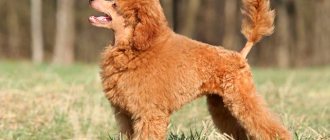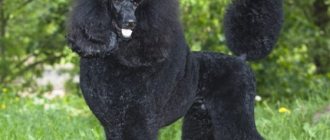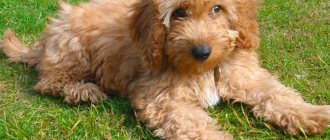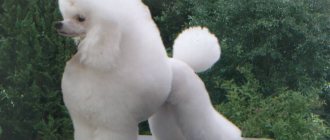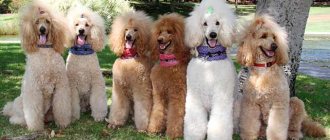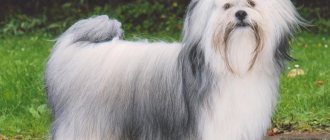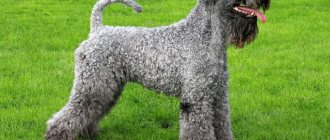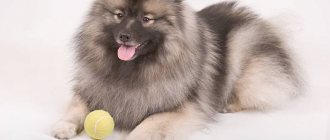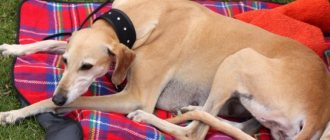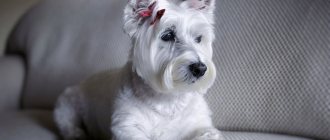Tiny representatives of the poodle breed look like a soft toy: they are cute, smart and extremely active creatures.
Tiny representatives of the poodle breed look like a soft toy: they are cute, smart and extremely active creatures. For its decorative nature, the breed received the appropriate name - toy poodle. Thick fur covers the dog’s body, and its extravagant haircut and elegant clothes invariably arouse the admiration of others.
Funny toy puppies appeared in our country not so long ago - in the last century. There is still no clear opinion as to where the birthplace of the breed is; several European countries competed for the right to “superiority.” In the 20th century, thanks to the efforts of the French Kennel Club, France achieved victory.
Soon a new dwarf breed standard was recognized, which was called the Toy Poodle. It is believed that the Toy breed was obtained as a result of selection of the Poodle, Retriever and Irish Water Spaniel. They wanted to use the new standard for hunting, so that the dog would bring shot game from the water.
Breed standard
The breed standard provides the following parameters: height at the withers - 23-25 cm (females), 25-28 cm (males), weight 6-8 kg. Description: proportional torso, slender muscular legs, proud posture and high head position. The toy has an elongated muzzle and drooping ears, long and flat, covered with hair. Small, neat paws with soft pads. The Toy puppy's tail is docked.
In terms of color, toy poodles come in two-color and one-color varieties. The classic standard is black, white and brown toy. The modern standard is apricot, red and silver. The recognized two-color colors are black and white and black and tan. The red toy is notable: the eyes and nose are black, and the color resembles the description of the mahogany Irish setter.
The breed has almond-shaped eyes located slightly obliquely. For black, white, red, silver and apricot poodles, the standard provides for black and brown eye colors; for brown poodles, the color is dark amber. The toy has a large nose, black or brown depending on the color.
The dwarf standard provides for two types of coat - corded and curly. The coat of the toy is dense and uniform, the fur is very thick, elastic and springy: if you press it with your hand, it easily restores its shape.
The Mini Toy Poodle is intelligent and capable of learning. This is a favorite breed of circus performers; they enjoy performing tricks, and having received well-deserved praise, the dog grows in its own eyes.
Puppies do not like to be left alone at home and can get quite mischievous in the absence of their owner. But if you accustom the puppy to your absences, the adult dog will tolerate loneliness quite calmly. Some people get another puppy so that the dogs together will not be bored.
The dog has an easy-going character, rarely barks and is very attached to its owner. She gets along well with children and is friendly towards guests, although the mini poodle is somewhat shy with other animals. Some people cannot stand scandals at all and may even get sick due to the difficult situation in the house.
This breed is a companion, intelligent and quick-witted, so it can be used for detection and hunting. But the dog is not suitable as a guard. The dwarf representative of the breed is too friendly and completely devoid of aggression.
Inactive and sedentary people should not get such a puppy: the dog is a very active breed, loves swimming and various games. And this is a fragile dog, even small children can accidentally injure it.
Description and character of the poodle dog breed.
Regardless of size, all poodles have the same character. These are cheerful, playful creatures that will brighten up the drabest everyday life of your family. Poodles love to play, run and move in general, so the breed ideally needs either a large family where it will be entertained with activity, or at least one active person who is ready to devote at least an hour a day to a busy walk. Without getting enough physical exercise, the dog will begin to throw out all its accumulated energy on all sorts of pranks, for example, it will start gnawing things in the house, will bark a lot, and will become aggressive towards family members or animals in the house.
But a walking poodle, exhausted from physical activity, turns into a peaceful, docile creature, ready to fall asleep on the owner’s lap or next to him, this already depends on the size of the dog. Having received a full-fledged walk, the dog will be much better able to learn new commands and obey the owner in general; it will be easier to educate him, wean him from bad habits and accustom him to the rules of behavior in the house. Even a first grade child can train and raise a poodle, and he will also be able to control the dog while walking. But parents should always be ready to help the child in his endeavors. Compared to other breeds, caring for a poodle requires special attention. You should brush your dog every day, wash it 1-2 times a week (as the coat gets dirty), and learn how to cut off excess hair on the dog’s body, or just take it to the groomer for a haircut once every two months.
For the most part, caring for a poodle comes down to the need to exercise the dog physically, because this is exactly what these dogs love so much. To walk your dog faster and better, you can buy tennis balls and use a sling you made yourself to throw balls over long distances, or buy a special slingshot, which costs about 700-900 Russian rubles. The diet of a poodle is no different from the diet of other breeds and should consist of one super premium dry food or only natural products purchased by the owner in advance according to how the diet is composed. It is difficult to say what is best to feed, so buy what is more convenient or profitable for you. Dry food does not require time to prepare, but its cost can be high, while natural food will take a lot of your time, but is somewhat cheaper. In addition, when preparing food yourself, you have the opportunity to monitor exactly what foods end up in your pet’s bowl.
Cloth
Short-haired poodles need warm clothing, especially the elderly and weakened; in winter, their joint diseases often worsen. That poodle has an underdeveloped undercoat, he freezes in cold weather, and he also needs clothes.
Kids need warm clothes: if it’s below -10 degrees outside, it’s better not to take the puppy out at all or to shorten the walking time. In addition, the clothes are more hygienic - in slushy weather, overalls will protect the baby from dirt.
Care and maintenance
Despite the long and thick coat, caring for a poodle does not require much time, but it is better to be prepared for the financial costs.
The dog's coat is trimmed regularly. There are many options for grooming your dog. The wool can be picked up, braided and hardened with multi-colored hairpins. Grooming a dog can be done at home or with the help of a special groomer. Haircut price from 1,500 rub. This is an additional expense, since the dog is cut at least once every three months. The rest of the time, the hair is combed out, since its structure is soft and without care, mats will form on the dog. If the wool has gathered into a tangle, it is combed out. Once every few months, the dog is washed with special detangling shampoos or simple baby shampoo. After washing, the wool is dried with a hairdryer, since it will take a long time for the “fur coat” to dry on its own, and this increases the likelihood of developing fungal diseases on the skin.
The dog's nails are trimmed every 2-3 weeks. In the summer, the claws wear off on the asphalt and the procedure is carried out less frequently.
Particular attention should be paid to the animal’s ears. Poodles have a predisposition to ear diseases, so when grooming, do not forget to pluck the hair from the ear.
Nutrition
The best way to prevent disease is proper nutrition and warm clothing. The puppy's diet should contain proteins, fats, vitamins and microelements. You can feed with dry food or create a diet of natural products: eggs, fish, meat and dairy products, cereals, vegetables and fruits, bones. You cannot feed meat alone.
Toy puppies eat well minced or boiled meat, cut into pieces, semi-liquid porridges - buckwheat, oatmeal, rice and millet. You can give crackers.
It is imperative to feed your poodle a plant-based diet. Carrots, cabbage, beets, tomatoes, cucumbers, herbs, fruits are finely chopped and added to the food. The puppy should always have clean water.
The daily amount of food for an adult toy is 350-450 grams. For pregnant and lactating bitches, the norm increases by 1.5-3 times. Puppies receive complementary food from the 10th day of life - they can be fed with warm milk with yolk or milk mixtures. From day 15, puppies receive minced meat, porridge, dairy products, and pureed vegetables.
You can’t feed Toy with the leftovers of the owner’s dinner. Such nutrition will invariably affect the growth and appearance of the poodle. Also, you should not overfeed it. The dwarf toy should look muscular and moderately fit, his ribs should be palpable.
If you are overweight, you need to walk more and reduce the proportion of flour products and cereals. You can feed your toy walnuts (0.5 nuts per day) or dried fruits. Smoked meats, sweets, pickles, pasta, legumes, potatoes, fatty meat and sharp bones should not be given to a poodle.
Classic haircuts
If you are the owner of a show-class poodle and are planning to participate in exhibitions, then keep in mind: your choice should vary only within the proposed options. A haircut that does not meet the standards is grounds for disqualification.
a lion
The poodle lion cut for poodles is considered to be the oldest of all styles. It was developed for optimal use of the dog's working qualities. For a haircut to be considered compliant with the standards, the groomer must:
- Shave the hair at the base of the tail by a third of the entire length and on the top of the paws, leaving a pompom at the end of the tail and “cuffs” at the ankles;
- Remove hair from the ends of the ears, while maintaining the whiskers on the upper lip;
- Shave the hair on the neck, affecting two-thirds of its length. The new shape should be similar to the letter V;
- Shape the pet's fur in the form of a “mane” on the front of the body;
- Shave the hairs on the back of your pet's body down to the ribs.
Two options are allowed on the head: either a “crown” of wool, or a cut forelock.
Continental
Reminiscent of a classic lion haircut, but differs in a large number of pompoms. The back of the body is not completely shaved; part of the hair is left to create two rounded pompoms. A pom-pom is also formed on the tail, “bracelets” are formed on the paws, and the groomer makes a beautiful mane on the chest. The separation between them is carefully shaved.
Scandinavian lion
The front part of the body is left voluminous and lush; here the groomer uses scissors to a minimum, giving the coat a semi-round shape. The hair on the back of the body is trimmed with a poodle clipper, but is not shaved. Only a small area at the very base of the ponytail is shaved, leaving a lush cap of hair on the head.
English saddle
Another variation of the “lion”, but here the mustache is shaved off, and the hair on the head is collected in a bun and secured with a ribbon or elastic band. The base of the tail, the upper limbs, the muzzle and the back of the body are shaved.
Modern poodle haircut
The shortest fur remains on the throat, chest, belly and buttocks. The claws are visible on the limbs; instead of a lush mane of wool, the groomer cuts out “pants” and “sleeves”. The hair on the muzzle, cheeks and base of the tail is shaved, and the back and sides are also shaved. A rounded pompom is made at the very tip of the tail, and a “crown” is formed in a semicircle on the top of the head. Boys are given not only a mustache, but also a goatee.
This haircut requires quite careful work from the groomer, because according to the standard, the length of the short coat should be exactly 1 cm.
Anglo-Saxon haircut
The front part is designed according to the “lion” principle, the hair on the sacrum and groin area is cut to 2 centimeters. At least ten centimeters are left on the heels; on the tail, two-thirds of the hair forms a lush pom-pom.
The hairstyle is “top note”, the hind legs are decorated with two-layer “cuffs”. They are separated by shaved borders. The mustache and beard on the face are shaved, and the throat and forearms of the front paws are also shaved.
Training
In addition to intelligence, intelligence and the desire to please the owner, poodles also have a clearly expressed sense of shame. This set makes training and education hassle-free. Commands are remembered instantly, their execution is “caught” after one or two impressions, and remains in memory forever.
Puppies love to play, and this is also a definite aid in training. The owner becomes a play partner, and the poodle perceives commands and execution as a game, tries to imitate the owner - this is how they are taught to put away toys and bring things.
You cannot shout or use physical force against a poodle. He himself tries not to give serious reasons for this.
If your pet is at fault, you need to briefly and calmly point out the mistake that was made. The main thing is to choose the time and place so that the poodle understands why he is being scolded. If there is understanding, he will correct himself.
The high intelligence of dogs of this breed allows the owner to communicate with them, talk a lot, and explain. This helps the pet better understand what is required of him.
If you don’t pay attention to raising a dog, you can end up with a pet without any concept of subordination or hierarchy, who considers himself to be in charge. This feature is especially characteristic of miniature and toy poodles.
We advise you to read: Border Collie Dog Breed
